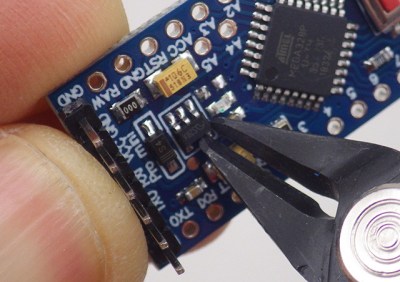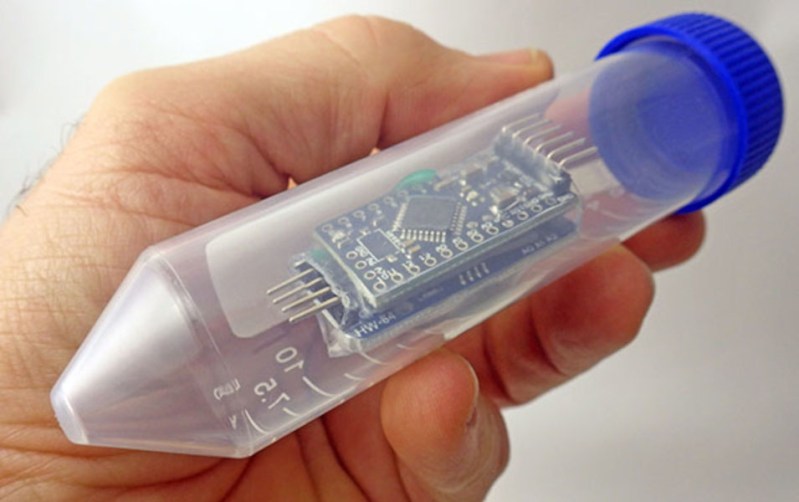Coin cells are great for backup power for things like real-time clocks, or even for powering incredibly small mechanical devices like watches. But for something like a data logger, running on a standard microcontroller, most people would reach for a lithium cell of some sort. Not so with this build, though, which squeezes every joule of energy from a coin cell in order to run a data logger for a full year.

Most of the design and engineering required to improve the efficiency of the data logger involve standard practices for low-power devices such as shutting off unnecessary components and putting the device to sleep when not actively running, but this build goes far beyond that. The Vcc pin on the RTC was clipped which disables some of its internal logic but still keeps its basic functionality intact.
All of the voltage regulators were removed or disabled in favor of custom circuitry that doesn’t waste as much energy. The status and power LEDs were removed where possible, and the entire data logger is equipped with custom energy-efficient code as well.
If you’re starting a low-power project, even one that isn’t a datalogger, it’s worth checking out this build to see just how far you can go if you’re willing to hack at a PCB with cutting tools and a soldering iron. As to why this data logger needed such a low power requirement, it turns out it’s part of a kit being used in classrooms and using a coin cell brought the price of the entire unit down tremendously. Even if you have lithium cells on hand, though, it’s still worthwhile to check out the low power modes of your microcontroller.
Thanks to [Adrian] for the tip!
















The CR2032 cell mentioned in the project page is a lithium cell:
https://en.wikipedia.org/wiki/Button_cell#Type_designation
CR2032:
C= lithium
R = round (cylindrical)
20 = 20 mm diameter
32 = 3.2 mm thickness
thanks for that I thought I was losing my mind when the article kept comparing a coin cell to a “lithium cell”. While I have plenty of LR44 button cells around (L type = alkaline), you’d likely want two to push a microcontroller.
A “CR” coin cell uses lithium manganese dioxide, but there is a also a less common “BR” coin cell that uses lithium poly-carbonmonofluoride. Both types are “lithium” coin cells.
The BR one also has a wider temperature range.
And there are also rechargeable types.
I forgot their name, typed in something and got on this site:
https://www.batteryequivalents.com/lithium-cr2032-dl2032-br2032-ml2032-lir2032-lr2032-batteries-equivalents-and-replacements.html
Apparently it’s the LiR2032, and some brand has an ML version.
Rechargable type only has 50mAh, compared to the 220mAh of a CR2032.
It may still be useful if it can be combined with some energy harvesting method.
Oops, misplaced a comma or so.
typed in some words, found “Energy Micro” which has apparently been taken over by Silicon Labs some years ago.
A quick read on https://en.wikipedia.org/wiki/EFM32 claims running @1MHz from 114uA, and Deep Sleep with RTC and ADC sampling once a second for an average of 1.3uA, and according to Wikipedia that should be 18+ years from a CR2032.
Do keep in mind that these are probably old numbers.
If you are really into low power uC’s you have to check and compare some datasheets.
But you knew what the hell they meant. Comments and thinking like this where you feel some need to claim superiority by correcting the author even though everybody involved understands exactly what they intended is not only unhelpful it’s counterproductive.
I don’t think it’s farfetched to imagine some reading this who does NOT know this. I think this leans toward the helpful side than the pedantic. Not to mention it spurred a lot of interesting information sharing! People are definitely far too pedantic on the Internet typically, but I think it’s unfair to treat all small corrections as if there’s malice in the intent.
Jeelabs has an incredible series of articles about getting years of battery life out of an AVR chip. Even if you’re targeting a different architecture, some of the techniques are instructive.
hm, bit surprised: thought the least-power low-bitwidth market was dominated by the MSP430? Do they have a direct comparison somewhere?
Also: I suspect going for an MCU with an integrated RTC might help reduce standby currents (reduced number of core voltage regulators -> less quiescent current), but then again, the process you might want to use for a low-power MCU core that still needs to perform efficiently at a couple MHz when not in sleep might be different to what you’d use on a dedicated RTC die. Then again, I don’t think the Atmega 328p is a low-power MCU by modern standards… hm.
One of our customers put a separate RTC on his board because the internal one drew too much current during standby. I don’t remember which SoC this was, but it was big enough to run Linux.
Not that uncommon of a solution – small simple chips tend to draw less than bigger, more capable chips even with a bunch of their features turned off.
As you go up the food chain, people tend to look at “low power” a little differently and when you’re sitting right next to the battery that you’re trying to eek as much life as you can from, there is room for a lot of creativity and load shedding can really pay off even if it costs you a few extra components.
I use a jeenode outdoors powered from a 18650 / 2600mAh
Sends ldr battery, temp and humidity every second .
Battery usually lasts a year, 9 months if it’s a really cold winter.
I really like the JeeLabs site.
It has very nice tutorials and explanations of what sort of stuff is needed to get the power consumption down.
He does (did?) use the Atmel AVR’s, and those are getting quite old.
MSP430 used to be very good at low power stuff, but that was also 10+ years ago.
These days there are many other uC families that have been optimized for very low power stuff.
I guess you can have a running (at 1MHz or so) uC from 100nA or less now-a-days, and I won’t be surprised if a uC with built-in RTC can go to single digit nA in sleep with just the RTC running.
I have an implanted pacemaker that claims to have over a decade of battery life left. It monitors every beat my heart takes, and advertises over BLE once a minute. I think that’s pretty amazing. I do wish it had a longer battery life or wifi energy harvesting or something, though, because I hear it’s somewhat inconvenient to do a battery swap. Maybe the next one I get will last 20 years.
Believe it or not they used to make nuclear powered pace makers!
Back in the day when I was building various 802.15.4-based low power wireless devices, someone asked me “How do you get it so that runs for years on a tiny battery?”
I told them, “You don’t do a lot, and you don’t do it very often.”
Good work here – there are a lot of small parasitic ways to build a very low efficiency battery powered heater and all those small draws add over time to kill your battery.
If only they had rechargeable cr cells
While that is some cool tinkering, looking at the size I would have just used 2 or 3 AA Batteries which would be real cheap, too. Hell if my M705 can run over 3 years of 8+ hours office work with 2 AA this logger should run for a decade
3D printed carrier rails and a couple of mini breadboards increases the flexibility of the 2-Part logger design for easier sensor swaps. And we’ve simplified the base code considerably for classroom lab activities with students who are new to the game.
https://thecavepearlproject.org/2023/12/01/the-e360-a-10-classroom-data-logger-for-science/
And we’ve created a method for calibrating the NTC thermistors on those 2-module loggers that is easily done at home. To the best of our knowledge this is the first time the water freezing process has been used for DIY NTC calibrations, instead of the more common ice-bath approach: https://thecavepearlproject.org/2024/04/20/a-practical-method-for-calibrating-ntc-thermistors/